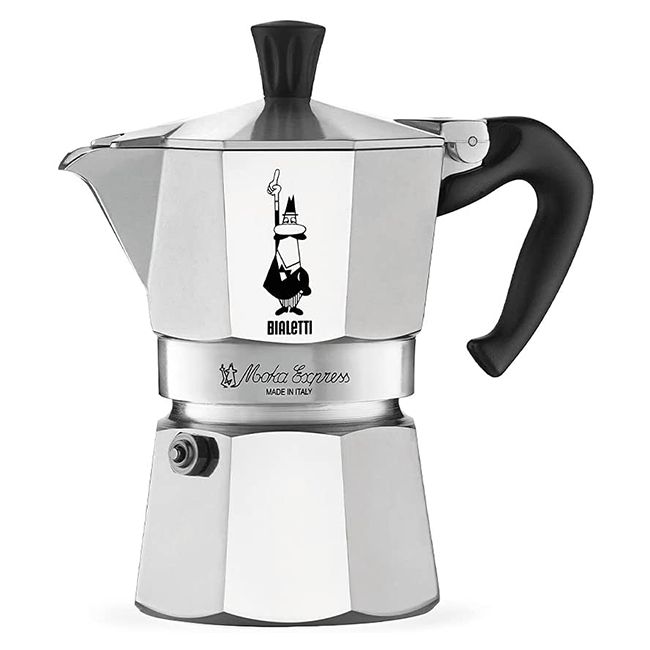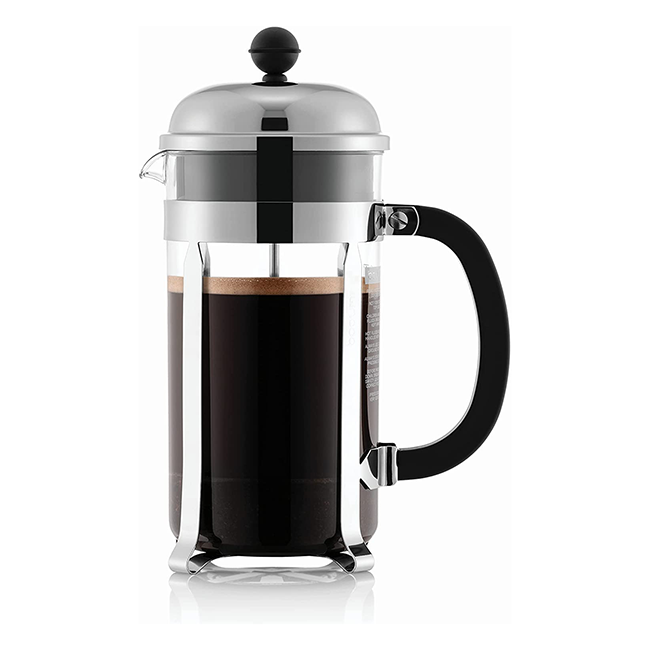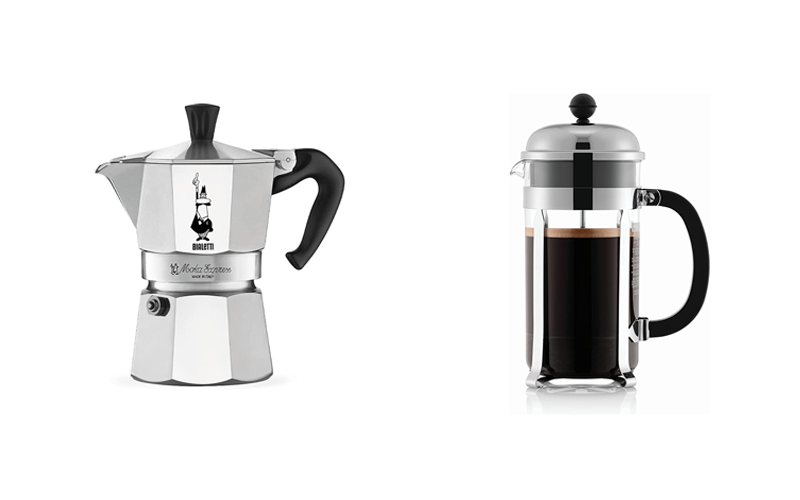When it comes to coffee, everyone has an opinion about which method of brewing is best. In the one camp, there are those decrying that the Moka pot is by far the best option for brewing delicious coffee. They have a point – it’s certainly tasty, strong, and easy to brew, and requires nothing more than a heat source and the Moka pot itself. In the other camp, French press die-hards proclaim their method to be superior. And, really, you can see their logic too. Affordable, simple to use, and requiring nothing more than hot water and the French press itself, there’s certainly a lot of merits to using this method. But which is superior?
At Caffeine Fiend, we use both often, and so are singularly equipped to answer this question once and for all. Below we’re going to do a deep dive into both methods, list their pros and cons, and try to give you an unbiased review to help you make the decision about which method is best for you.
The Moka Pot
The Moka Pot is one of the most common methods for brewing coffee worldwide. It is used cross-culturally in households in almost every country in the world and is praised for its affordability, ease of use, and ability to brew strong-bodied and delicious coffee.
The device consists of three chambers that fit into each other. The bottom chamber holds the water, the middle part is the filter basket which holds the coffee grounds, and the top chamber collects the final product once it has finished brewing. Once the Moka pot is prepared and assembled, it is placed over a heat source that will boil the water in the bottom chamber. As the water turns into steam, the pressure forces it through the filter basket and the ground coffee into the upper charmer. During the process, the steam extracts the coffee grounds, cools into back into a liquid (albeit a hot one), and gathers into a concentrated coffee in the top chamber.
How to use a Moka pot correctly
- Disassemble the entire Moka pot so that the bottom chamber, carafe, and top chamber are separate.
- Add water to the bottom chamber until it’s just below the pressure-release valve. Don’t add water above this point as it might result in either your coffee becoming over-extracted or the entire exploding due to the build-up of pressure.
- Next, add your coffee to the filter basket. As with all Moka pots, a medium to medium-fine grind works best. If it’s any finer then there’s a chance the filter basket will get clogged, leading to uneven extraction. If you’re using a 3-cup Moka pot, then you should be using about 18 grams of coffee per serving. Also worth noting is that you shouldn’t tamp down the grounds the same way that you would in an espresso machine; this might lead to the filter basket being too tightly packed and the water unable to force its way into the top chamber.
- Reassemble the Moka pot by placing the filter basket into the bottom water chamber then screwing on the top chamber. Next, place the assembled Moka pot on a stove or other heat source.
- After a few minutes, you will hear the steam begin to make its way from the water chamber into the top chamber. When you start to hear a gurgling sound, remove the Moka pot from the heat source and let the process finish. Once the gurgling has stopped, your coffee is ready to be poured.
Pros
- Affordable
- A high-quality Moka pot is durable and will last years
- Produces espresso-like coffee without the need for an espresso machine
- Easy to clean
Cons
- Doesn’t produce authentic espresso
- Takes relatively long to brew a pot of coffee when compared to a French press
The French Press
Invented by Ugo Paolini in 1923 and refined by Italian designer Attilio Calimani in 1928, the French press, like the Moka pot, is one of the most ubiquitous brewing methods in the world. No matter if it’s a friend’s house or your local artisan cafe, the French press is used everywhere in favor of other brewing methods such as drip coffee machines due to their ability to extract effectively and deliver rich and full-bodied coffee. It’s also relatively fast to use and brew, which makes it an ideal method for commercial use.
The way that a French press is able to create such a delicious brew is by using a precise steeping process. Unlike the Moka pot which relies on pressure and heat, the French press works by covering coarsely ground coffee with near-boiling water for around four minutes (although the times vary depending on how strong you would like your coffee to be), and then separating them from the final brew using a metal filter on a plunger (which is why French press is also called plunger coffee). Let’s take a look at the process in more detail:
How to Make Coffee Using a French Press
- The first step is to place the press on a flat surface, keep the handle steady and remove the plunger.
- Next, heat your water. You want the water to be hot but not boiling. The ideal temperature and is between 195 and 205 degrees Fahrenheit. If you want to be exact, we recommend investing in a gooseneck kettle that will allow you to precisely set the temperature of the water you’re heating.
- While the water heats, turn your attention to your beans. You can buy your coffee pre-ground, but we always recommend grinding the beans yourself in order to have your coffee as fresh as possible. If you are grinding your own beans, make sure you set your grinder to a medium-coarse setting. This allows the grounds to have the greatest amount of surface area exposed to the water during steeping and will result in the most effective extraction. Check out this article for our favorite grinders to use while making French press.
- Next, spoon coffee into the carafe of the French press according to your desired strength and the size of the press. You’ll need about two tablespoons or 28 grams of grounds for a 0.5l carafe, and about six tablespoons or 80 grams, for a 1.5l carafe.
- Once your water has reached the required temperature, add it to the carafe. Make sure you leave a gap at the top or else the coffee will spill when you insert your plunger.
- Stir the mixture with a spoon to ensure that all of the coffee grounds are fully submerged and saturated. Once you’ve given it one or two stirs, remove the spoon and let it rest so that the grounds can settle to the bottom of the carafe.
- Place the plunger on top of the carafe and let it rest there. This will help retain the heat and keep it as warm as possible.
- Next, set a timer for between 3.5 and 4 minutes. While some may steep slightly less than this, it’s important that you don’t go for any longer, or else you risk over-extraction and ruining the flavor of the coffee.
- Once the timer is up, press the plunger gently with one hand until it reaches all the way to the bottom. Ideally, you should feel a little bit of resistance. This is a good sign as it means the coffee grounds are the right consistency. If it plunges too easily then it means that the coffee you used was ground too finely.
- Pour and enjoy!
- If you have any coffee left over, decant it into a jar to stop the extraction process and save it for the next cup.
Pros
- Easy to use
- Easy to master
- Brewing only takes four minutes
- Quick and easy to clean
- Inexpensive especially when compared to other brewing methods
- Can also be used as a cold brew coffee maker
Cons
- Sometimes sediment makes its way into the final brew
- If left unchecked over-extraction can occur
- The taste of the coffee can vary if you don’t pay attention while brewing
Moka Pot vs French Press: Key Differences
- The Moka pot relies on pressure and heat for efficient extraction, while the French press relies on steeping and saturation.
- The Moka takes anywhere from 5 – 10 minutes to brew depending on the heat source, whereas a French press usually takes about 4 minutes.
- Moka pots are constructed from steel and aluminum whereas French presses are usually constructed from glass (although sometimes they might use stainless steel or ceramics).
- Moka pots produce a concentrated coffee with an espresso-like consistency whereas the coffee produced by the French press is not as strong.
- Moka pots can produce something close to a crema, whereas French presses cannot.
- The Moka pot uses a fine grind while the French press uses a medium-coarse grind.
Moka Pot vs French Press: What They Have In Common
- Both methods are easy to use, especially for beginners.
- Both methods are popular throughout the world and are used regularly in the home.
Buy A Moka Pot: Our Top Pick

When it comes to the best Moka pot there’s no denying that the Bialetti Moka Express takes first place. The original Moka pot’s construction dates back almost 100 years to 1933, and since then Bialetti has refined its design and continued to provide the world with a straightforward and affordable way of making delicious coffee.
Constructed from aluminum, the Moka Express is designed to be light, durable, and long-lasting. It’s the ideal not only in the home but also for taking with on business trips or camping excursions. As discussed above, operating this device couldn’t be simpler and all it requires is a heat source to brew a delicious batch of coffee. It’s available in a number of different sizes from a minuscule 1 cup all the way to a crowd-pleasing 12-cup.
The Moka Express is also really easy to clean. Because of its aluminum construction, it can’t be put in the dishwasher or be washed with detergents. Instead, all you have to do is give it a thorough rinse with warm water and it’s ready for the next brew.
Buy A French Press: Our Top Pick

When it comes to the best French press, there’s one brand that stands head and shoulders above the rest: the Bodum Chambord. With a carafe constructed borosilicate glass and a frame of stainless steel, the Chambord is designed to not only retain heat and look great but also last for years to come. It uses a 3-part stainless steel plunger and mesh filter in order to ensure that the best possible extraction takes place without any sediment making its way into your final brew. The mesh filter is also reusable, meaning you don’t have to waste money (or carbon) on one-use paper filters.
While the model that we linked to can make up to 34 ounces of coffee per serving, the Chambord is also available in a 12-, 17-, and 51-ounce model.
Moka Pot FAQs:
Is Moka coffee as strong as espresso?
The short answer is no. Coffee made with a Moka pot isn’t as strong as coffee made from a commercial espresso machine, however, it is quite a bit stronger than ordinary drip coffee or coffee made with a French press. This is because the pressure generated by the espresso machine is much greater than the Moka pot, and resulted in a much more effective and efficient extraction. That being said, Moka coffee is still a very rich and intense method of brewing coffee.
What size Moka pot should I buy for a single person?
When buying a Moka pot keep in mind that the cup system of measurement doesn’t equate to the size of an actual mug that you would drink out of. A “cup”, in this case, equates to about 50ml of volume. So if you’re buying a 3-cup Moka pot, expect to get about 150ml of brew, which should be fine for one person having two cups of coffee, or two people having one each.
Why does the coffee from my Moka pot taste bitter?
If your final brew tastes bitter instead of dark and intense, then it’s likely because you’ve over-extracted your coffee grounds. This can happen when you put in too much water, which causes your coffee to boil instead of being extracted via pressure and steam.

